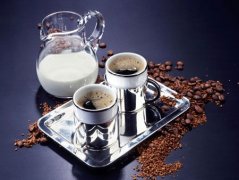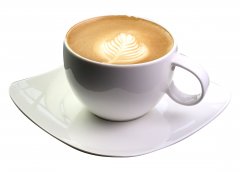What is the influence of Italian espresso on world coffee
Like enthusiastic Italians, Italian coffee is famous for its rich and mellow flavor. Espresso (Espresso) is the most representative Italian coffee. Americans call it "Espresso" to fully express the meaning of rapid extraction. At first, he was only popular in Italy, France, Spain and other southern European countries, but later swept across the Americas and became one of the most popular drinks. Even in Britain, known as the "black tea country", you can smell the aroma of espresso in the air everywhere.

Italian espresso
History.
The birth of espresso has gone through a long process. In the past few hundred years, people have conducted in-depth and comprehensive research on the processing and extraction methods of coffee. After repeated improvement experiments, the Italian espresso was finally developed. Therefore, Italians call its birth "the crystallization of science and art". The great Naples playwright Edouard de Filippo wrote in his memoirs: "when I was a child, it was the business of adults to stir-fry coffee. After they pour the coffee beans into the barrel, they turn the barrel and keep stir-frying until the coffee beans turn dark brown. The strong smell of coffee floated into my room through the window and woke me up from my sleep. So I knew the intoxicating taste of coffee long before I got my parents' permission. "
Italian coffee culture has developed for hundreds of years, and in this process, Italians have accumulated a lot of experience and perfect craftsmanship. They strictly check the quality and roasting degree of coffee beans. Roasting coffee is the most difficult step in the process of making coffee, and it is also the core link to improve the quality of coffee. The selection of high-quality fresh raw beans in the right roasting heat is a very necessary basic link in the production of Italian espresso. In order to produce high-quality Italian espresso, responsible Italian coffee wholesalers first buy raw beans from various coffee producing areas around the world, and then conduct secondary screening with a selection machine in the coffee factory. Experts agree that only by strictly checking the quality of coffee beans can we produce excellent Italian espresso.
However, although most coffee drinks are based on espresso, not all Italians like espresso. Some other types of coffee are also popular with Italians. Examples include lattes with milk added to espresso, Macchiato with rich milk foam, "Romano" coffee with a curly lemon peel and espresso with pure cream.
Origin
Italian espresso comes from Turkish coffee, but because Turkish coffee takes too long to meet the needs of fast-paced society, more and more people begin to study efficient coffee-making methods. A kind of Italian mocha pot called "Moka Pot Espresso" came into being. In 1906, the first commercial Italian espresso machine appeared in the world. In 1945, Gigia continued to improve the coffee machine. The Italian espresso machine has gradually become what it is now. 70% of coffee appliances produced in Italy are sold abroad.
Italian espresso machine uses the principle of air compression, can extract coffee in a very short time, and will not change the taste of coffee. He can also extract the very valuable coffee foam "Klima" in the eyes of the Turks at the same time, which can be called the most scientific way to extract coffee.
The production method of mixed coffee and coffee drinks has also been improved and improved by the introduction of new production technology by the factory, and the whole production process of coffee is more foolproof. As a result, the Italian coffee processing industry without raw beans has achieved great success. According to the latest survey, Italy exports coffee to more than 100 countries around the world every year, making it the second largest coffee exporter in the world.
French baking (French Roast) and Italian baking (Italy Roast) are the most representative depth baking. The surface color of French-roasted coffee beans is close to dark brown or black. On the other hand, the surface of Italian-roasted coffee beans is almost pure black and glossy.
Italian roasting is developed for the production of espresso, so it is also known as Espresso Roast. Even if a very small amount of raw beans are roasted, they can also feel scorched and bitter, making Italian roasting unsuitable for making lighter coffee. Due to the long baking time, caffeine in coffee has been basically lost. Therefore, compared with light coffee, deep-roasted coffee has a relatively low caffeine content. It is precisely because of this that Italian espresso is low.
Taste characteristics
Italian espresso has a strong flavor, bitter taste and astringent taste, only fresh coffee can emit a unique strong aroma. The best amount of Italian espresso is: a cup of water to 10.5 grams of coffee powder. American espresso is generally configured with a cup of water to 12.25 grams of coffee powder. Espresso prepared in this proportion is called "Espresso Single" or "Espresso Solo".
The coffee that is more bitter and stronger than espresso is Espresso Double, which is often translated as "double espresso". His configuration ratio is a cup of water heap 140g coffee powder. At first glance, the name Espresso Double thought there was twice as much coffee powder as Espresso Single, but this is not the case. But there is a kind of coffee called "Espresso Double", which puts double Espresso in one cup.
Coffee called "Espresso Lungo" refers to a cup of coffee powder to twice the amount of water. The word "Lungo" is in Italian, which means "Long" and "long" in English. Espresso Lungo tastes lighter than Italian espresso (Espresso Solo). There is a coffee that is just the opposite of Espresso Lungo, with a ratio of one cup of coffee powder to 2 cups of water. This kind of coffee is called "Espresso Ristretto" (Ristretto means "restrained, restricted).
In addition, there are many interesting coffee names. For example, there is a kind of coffee called Hammer Head in the United States, which is made by adding ordinary coffee to Italian espresso at 1:2. There is also a "special coffee" (Cafe Americano), which is specially prepared by Europeans for American tourists. The way to do this is to pour a certain amount of hot water into the already good espresso, and then pour it into an 8-ounce cup to serve to the customer.
Today's Italian cafes are mainly divided into two types: "Caffe" (coffee is called Cafe in France and Caffe in Italy) and "Espresso Bar". "Espresso Bar" is a place to provide coffee quickly for office workers. In Italy, we often see well-dressed office workers go to the coffee bar before going to work, drink a small cup of morning coffee (Morning Coffee, usually espresso) as quickly as possible, and then leave in a hurry. In the afternoon, the coffee bar is not lonely. Many people are used to going to the coffee bar in the afternoon, ordering a cup of espresso and a cup of "Straight Whisky" and drinking it one mouthful at a time.
Important Notice :
前街咖啡 FrontStreet Coffee has moved to new addredd:
FrontStreet Coffee Address: 315,Donghua East Road,GuangZhou
Tel:020 38364473
- Prev

What is white coffee? White coffee is native to Malaysia.
It is said that white coffee is a native and domestic product of Malaysia, which has a long history of more than half a century in Malaysia. Its history can be traced back to 1958. It is said that there was an old master who had been making coffee in a coffee shop for 30 years. One day he tried to use the method of going to Qiancunqing without adding gum, vegetable oil or any ingredients to stir-fry the coffee. Then mix the skim evaporated milk.
- Next

The wonderful use of coffee in daily life can reduce the smell of the refrigerator.
The wonderful use of coffee in daily life ① coffee grounds are put in the ashtray to dispel the odor and extinguish the cigarette ash more easily. ② coffee can refresh the mind, the smell of coffee is equivalent to absorbing lemon vitamin C, with whitening effect, people who do not drink coffee can give it a try. After eating garlic, green onions and other food, ③ can refresh his breath by drinking a cup of coffee. ④ will make coffee
Related
- Beginners will see the "Coffee pull flower" guide!
- What is the difference between ice blog purified milk and ordinary milk coffee?
- Why is the Philippines the largest producer of crops in Liberia?
- For coffee extraction, should the fine powder be retained?
- How does extracted espresso fill pressed powder? How much strength does it take to press the powder?
- How to make jasmine cold extract coffee? Is the jasmine + latte good?
- Will this little toy really make the coffee taste better? How does Lily Drip affect coffee extraction?
- Will the action of slapping the filter cup also affect coffee extraction?
- What's the difference between powder-to-water ratio and powder-to-liquid ratio?
- What is the Ethiopian local species? What does it have to do with Heirloom native species?

